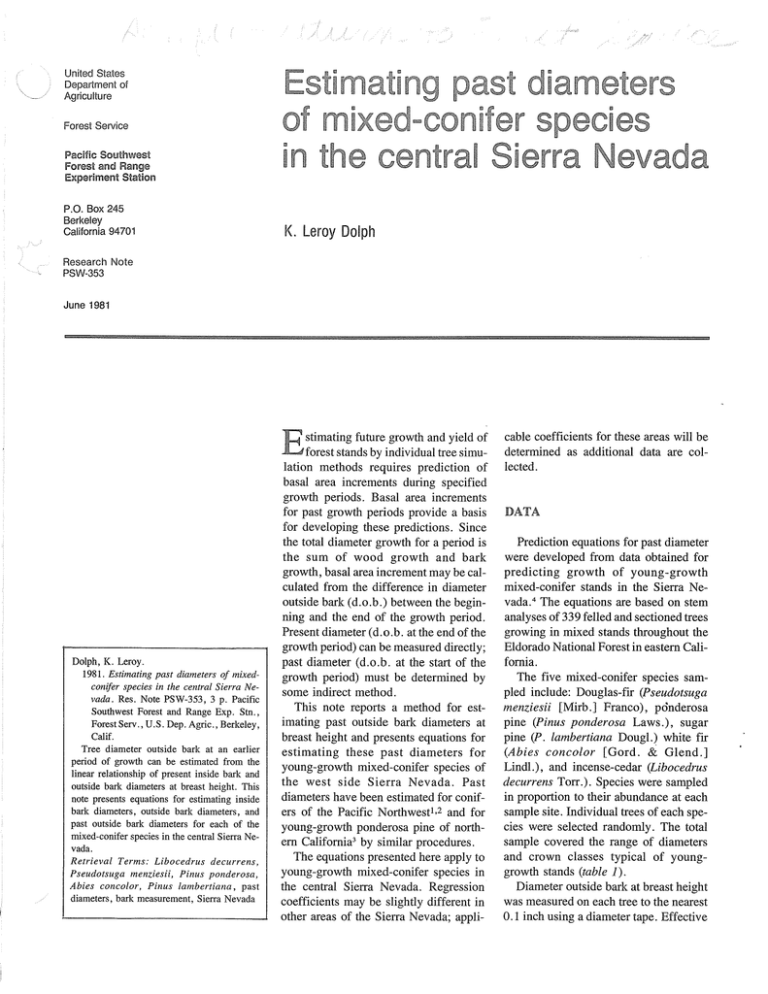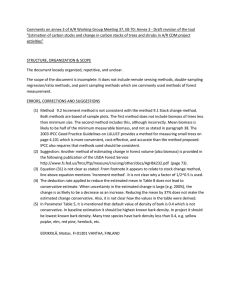species Estimating past diameters r
advertisement

- United States Department of Agriculture Forest Service Pacific Southwest Forest and Range Experiment Station P.O.Box 245 Berkeley California 94701 Estimating past diameters r species ierra Nevada K. Leroy Dolph Research Note PSW-353 June 1981 E Dolph, K. Leroy. 198 1. Estimating past diameters of mixedconifer species in the central Sierra Nevada. Res. Note PSW-353, 3 p. Pacific Southwest Forest and Range Exp. Stn., Forest Serv., U.S. Dep. Agric., Berkeley, Calif. Tree diameter outside bark at an earlier period of growth can be estimated from the linear relationship of present inside bark and outside bark diameters at breast height. This note presents equations for estimating inside bark diameters, outside bark diameters, and past outside bark diameters for each of the mixed-conifer species in the central Sierra Nevada. Retrieval Terms: Libocedrus decurrens, Pseudotslcga metzziesii, Pinus ponderosa, Abies concolor, Pirzus Earnbertiana, past diameters, bark measurement, Sierra Nevada stimating future growth and yield of forest stands by individual tree simulation methods requires prediction of basal area increments during specified growth periods. Basal area increments for past growth periods provide a basis for developing these predictions. Since the total diameter growth for a period is the sum of wood growth and bark growth, basal area increment may be calculated from the difference in diameter outside bark (d.0.b.) between the beginning and the end of the growth period. Present diameter (d.0.b. at the end of the growth period) can be measured directly; past diameter (d.0.b. at the start of the growth period) must be determined by some indirect method. This note reports a method for estimating past outside bark diameters at breast height and presents equations for estimating these past diameters for young-growth mixed-conifer species of the west side Sierra Nevada. Past diameters have been estimated for conifers of the Pacific Northwest132 and for young-growth ponderosa pine of northern California3 by similar procedures. The equations presented here apply to young-growth mixed-conifer species in the central Sierra Nevada. Regression coefficients may be slightly different in other areas of the Sierra Nevada; appli- cable coefficients for these areas will be determined as additional data are collected. DATA Prediction equations for past diameter were developed from data obtained for predicting growth of young-growth mixed-conifer stands in the Sierra Ne~ a d aThe . ~ equations are based on stem analyses of 339 felled and sectioned trees growing in mixed stands throughout the Eldorado National Forest in eastern California. The five mixed-conifer species sampled include: Douglas-fir (Pseudotsuga menziesii [Mirb .] Franco) , pdnderosa pine (Pinus ponderosa Laws .), sugar pine (P. lambertiana Dougl.) white fir (Abies concolor [Gord. & Glend.] Lindl.), and incense-cedar (Libocedrus decurrens Torr.). Species were sampled in proportion to their abundance at each sample site. Individual trees of each species were selected randomly. The total sample covered the range of diameters and crown classes typical of younggrowth stands (table I ) . Diameter outside bark at breast height was measured on each tree to the nearest 0.1 inch using a diameter tape. Effective Table 1-Number and diameter range of satnple trees D.b.h. (outside Species bark) range P 4.2 to 19.6 4.0 to 31.7 4.8 to 23.6 2.9 to 33.7 3.5 to 23.1 Ponderosa pine Sugar pine White fir Incense-cedar Douglas-fir d.i.b. = 0.8497 (d.0.b.) 0.2394 (r2 = 0.999, Syx = 0.114) d.0.b. = 1.1759 (d.i.b.) - 0.2721 (r2 = 0.999, Sy, = 0.134) Past d.0.b. = present d.0.b. - 2.3518(R) + Mean Standard d.b.h. error 13.9 10.3 6.49 5.77 4.71 -inches - Ponderosa pine d.i.b. = 0.9040 (d.0.b.) - 0.6103 (r2 = 0.997, Syx = 0.328) d.o.b. = 1.1029 (d.i.b.) 0.7162 (rZ = 0.997, Syx = 0.362) Past d.0.b. = present d.0.b. - 2.2058(R) + bark thickness was determined by averaging eight uniformly spaced measurements of bark thickness, each taken to the nearest 0.05 inch, by the "wood to ~ inside bark tape" m e t h ~ d .Diameter (d.i.b.) was then calculated by subtracting twice the average bark thickness from the d.o .b . measurement. METHODS If a linear relationship between d.o.b. andd.i.b. exists, andif current d.i.b. (d,) is known, current d.0.b. (D,) can be estimated by an equation of the form Dc = bo bldc (1) where bo and bl are regression parameters that can be estimated by least squares. Assuming these parameters are constant over a short period of time, such as a 10-year growth period, d.0.b. at the beginning of the period (Dp) could also be estimated from the d.i .b. at the beginning of the period (dp) using the relationship Dp = bo + bldp (2) The change in d.o.b. during a growth period (DA) is DA = D, - Dp and the combined equation of (1) and (2) above may be expressed D, - Dp = (bo bldc) - (bo bldp) and -, - Dc - Dp = bl (d, - d,), i3): -- >: The change in d.i.b. during the growth period (dA)is dA = dc - dp which is equal to twice the average radial growth during the period. Radial wood growth for any desired period may be easily measured from increment cores. Two or more cores per tree should be measured6and the average radial growth + + + calculated. If we let R equal this average growth for a specified period, then dA = d, - dp = 2R By substituting this value (2R) into equation (3) and rearranging terms, we obtain Dp = Dc - b12R (4) This equation, which accounts for the growth of both wood and bark, expresses past outside bark diameter in terms of present outs'ide bark diameter and radial growth. If radial wood growth can be predicted for future growth periods, the relationship DA = bldA can also be used for estimating future d.o.b. (Df). In this case, Df = D, b12R + Plotting of d.o .b. over d.i.b. yielded a linear relationship for each of the mixed-conifer species. Linear regression was used to predict (1) d.o.b. as a function of d.i.b. and (2) d.i.b. as a function of d.o.b. Examination of residual plots showed the variance was not constant but increased with larger tree diameters. Parameter estimates were obtained using weighted least squares analysis. t RESULTS AND DISCUSSION Regression equations which express the linear relationships of d.o.b. and d.i.b., coefficients of determination (r2), standard errors of estimate, and the past d.0.b. prediction equation are shown for each of the mixed-conifer species: Sugar pine d.i.b. = 0.8859 (d.0.b.) - 0.1813 (r2 = 0.997, Syx = 0.345) d.o.b. = 1.1252 (d.i.b.) + 0.2488 (r2 = 0.997, Sy, = 0.389) Past d.o.b. = present d.0.b. - 2.2504(R) m i t e fir d.i.b. = 0.8878 (d.0.b.) - 0.1451 (r2 = 0.998, Syx = 0.241) d.o.b. = 1.1238 (d.i.b.) + 0.1952 (r2 = 0.998, Sy, = 0.271) Past d.o.b. = present d.0.b. - 2.2476(R) Incense-cedar d.i.b. = 0.8300 (d.0.b.) + 0.0887 (r2 = 0.993, Sy, = 0.299) d.0.b. = 1.1975 (d.i.b.) - 0.0427 (r2 = 0.993, Sy, = 0.359) Past d.o.b. = present d.0.b. - 2.3950(R) The method given here for estimating past outside bark diameters is a refinement of the method given by Myers and Ale~ander.~ Using the relationship DA = bldA eliminates the need of using crossproducts of regression coefficients and intercept terms as shown in their prediction equation. The estimate of bl can be considered an indirect estimate of wood and bark growth since it indicates the change in outside bark diameter per unit change in inside bark diameter (DA/dA). The coefficient estimate for a given species, though useful in one area, may not apply in another, largely due to genetic variation, differences in site condi- Table 2--Coe@icierzt estimates of DA/dAfor three west coast conifer species Pacific Northwest Northern California Powers3 1.214 lions, and differences in stand ages. suggests that curvilinear regression Table 2 gives a comparison of coefficient would be required beyond the lower estimates found by different inves- range of the data. If an estimate of d.i.b. tigators for three west coast conifer spe- is needed below the range of diameters shown in table I , an approximate value cies. The estimate of the coefficients for may be obtained by drawing a line from each species in a given area is also an the lower end of each regression to the indication of relative bark thickness. origin. Analysis of variance of the regression Among trees of equal age and outside bark diameter, those which have larger coefficients was used to test for species estimates of coefficient values will, on differences. Controlling the overall a level at 0.05 by using the Bonferroni the average, have thicker bark. Equations for predicting inside bark multiple comparison technique,* showed diameters from measurements of outside the following: The regression lines for Douglas-fir, bark diameters have been shown for each white fir, and sugar pine were not species. These estimates are useful for significantly different. determining the peeled wood volume of a , \ There was not enough evidence to tree. The relation between d.i.b. and show the regression lines of sugar d.0.b. for each species is apparently pine and ponderosa pine to be siglinear for the range of diameters sampled. The relationship should logically ~ n i f i c a n t l ydifferent. The regression line for incenseshow zero d.i.b. for zero d.0.b. When cedar was significantly different the intercept term in the regression equa- % from those of the other species. tion is some value other than zero, it r- r NOTES 'Johnson, Floyd A. 1955. Estimating past diameters of Douglas-fir trees. U.S. Forest Serv. Pacific Northwest Forest and Range Exp. Stn. Res. Note 112, 3 p., illus., Portland, Oreg. Johnson, Floyd A. 1956. Use of a bark thickness-free diameter relationshipfor estimating past diameters ofponderosa pine trees. U.S. Forest S e n . Pacific Northwest Forest and Range Exp. Stn. Res. Note 126, 3 p., illus., Portland, Oreg. =Spada, Benjamin. 1960. Estimating past diameters of several species in the porzderosa pine subregion of Oregon and Washitzgto~z.U.S. Forest Serv. Pacific Northwest Forest and Range Exp. Stn. Res. Note 181, 4 p. Portland, Oreg. 3Powers, Robert F. 1969. Estimating past diameters of ponderosa pine in northern California. USDA Forest Sew. Res. Note PSW-194,3 p., illus. Pacific Southwest Forest and Range Exp. Stn., Berkeley, Calif. 4Dolph, K. Leroy, and Elliot L. Amidon. 1979. Predictirzg growth of mixed-conifer species in the Sierra Nevada: rationale and methods. Res. Note PSW-339,7 p., illus. Pacific SouthwestForest and Range Exp. Stn., Forest Sew., U.S. Dep. Agric., Berkeley, Calif. SMesavage, Clement. 1969. Measuring bark thickness. J . For. 67(8): 753-754. 6Arnidon,Elliot L., and K. Leroy Dolph. 1979. Two cores are better than one: predicting mixedconifer growth in the Sierra Nevada. Res. Note PSW-340,3 p. Pacific SouthwestForest and Range Exp. Stn., Forest Serv., U.S. Dep. Agric., Berkeley, Calif. 'Meyers, Clifford A., and Robert R. Alexander. 1972. Bark thickness and past diameters of Engelmann Spruce in Colorado and Wyoming. USDA Forest S e n . Res. Note RM-217,2 p. Rocky Mountain Forest and Range Exp. Stn., Forest Sew., U.S. Dep. Agric., Fort Collins, Colo. *Miller, Rupert G., Jr. 1966. Simultaneous statistical inference. p. 67-70. McGraw-Hill, Inc., New York. The Author K. LEROY DBLBH, a research forester assigned to the Station's Silviculture of Sierra Nevada Conifer Types research unit in Redding, Calif., received a B.S. degree (1969) in forest management and an M.S. degree (1971) in forest ecology from Colorado State University.


